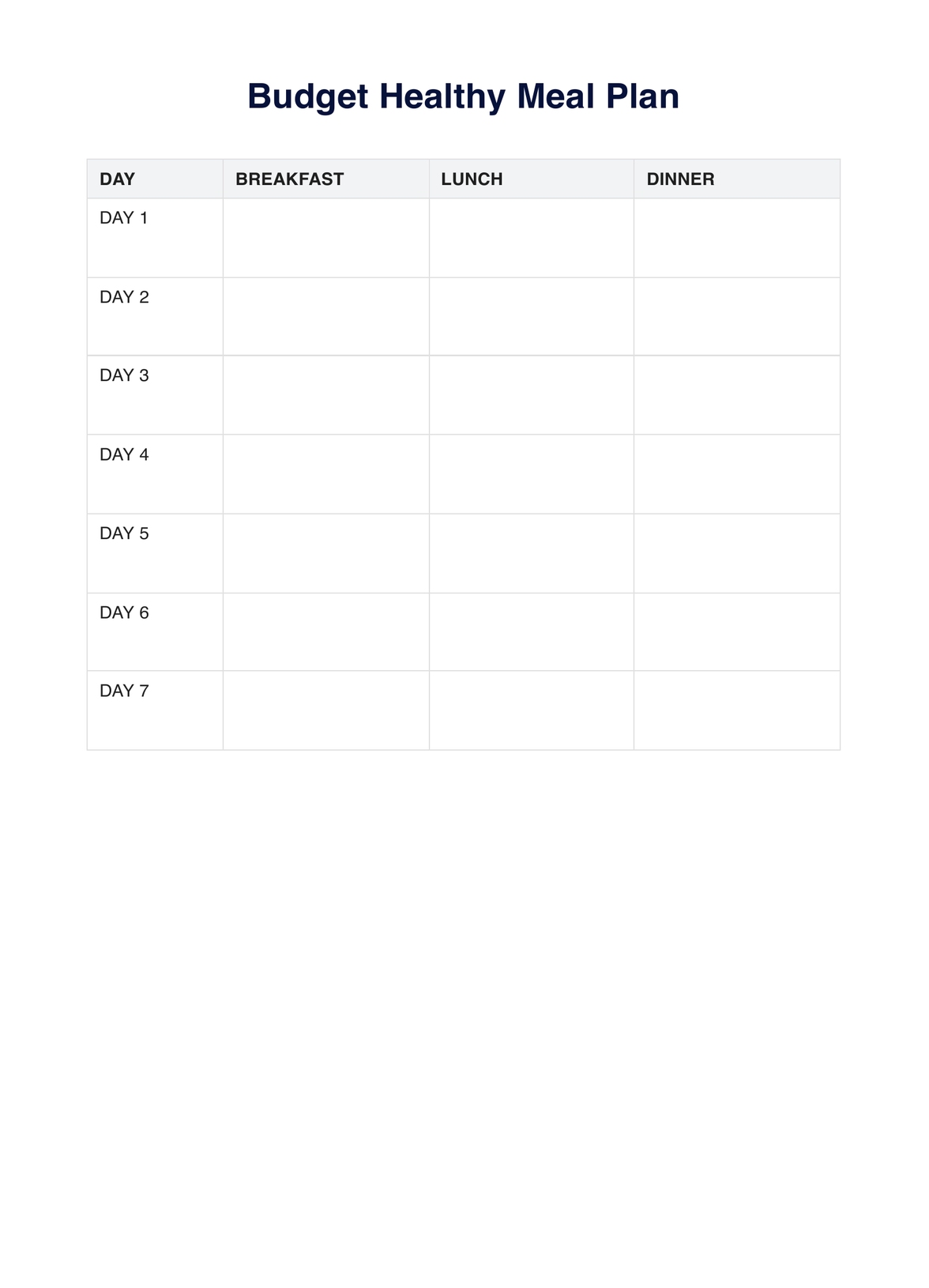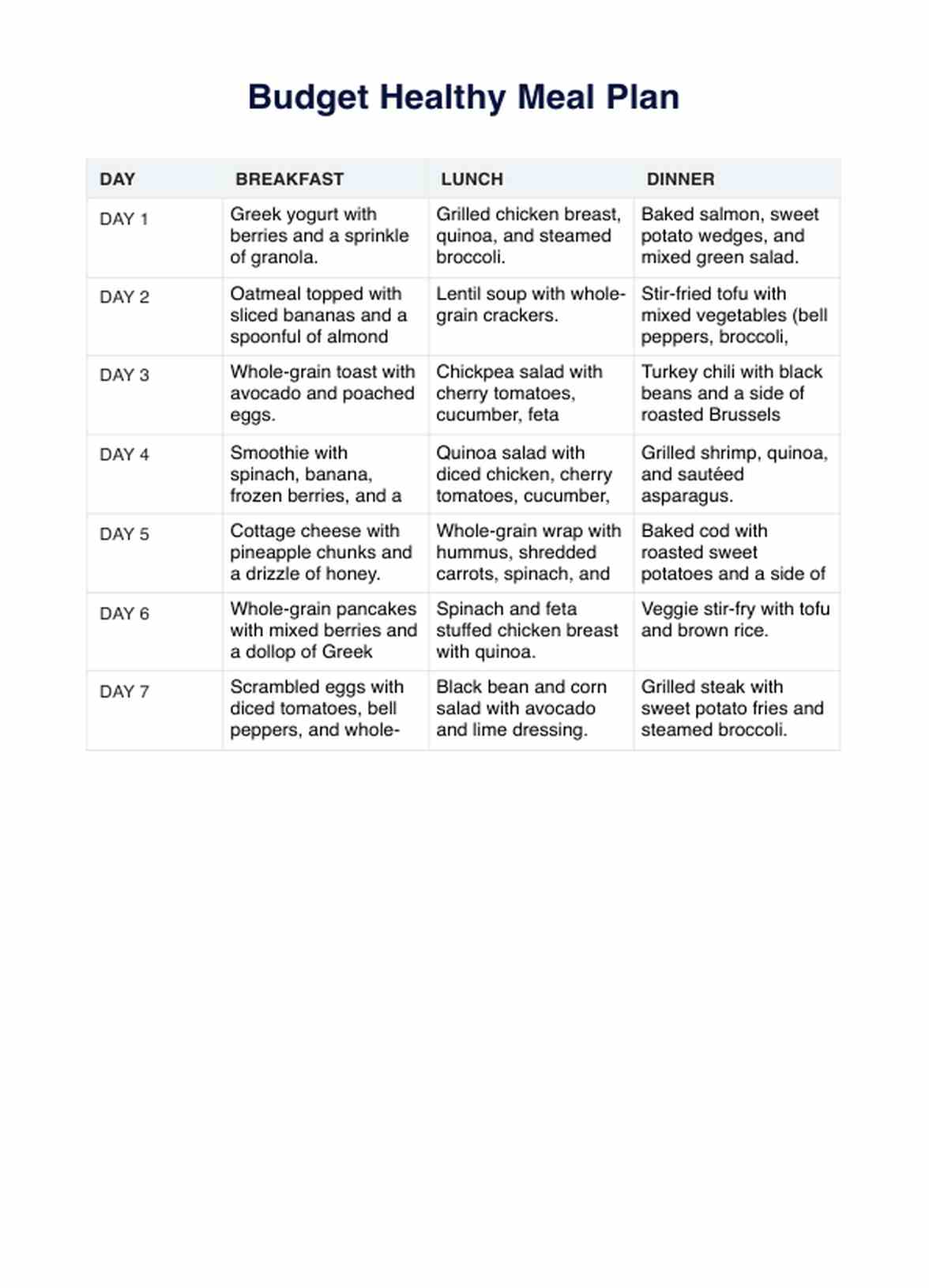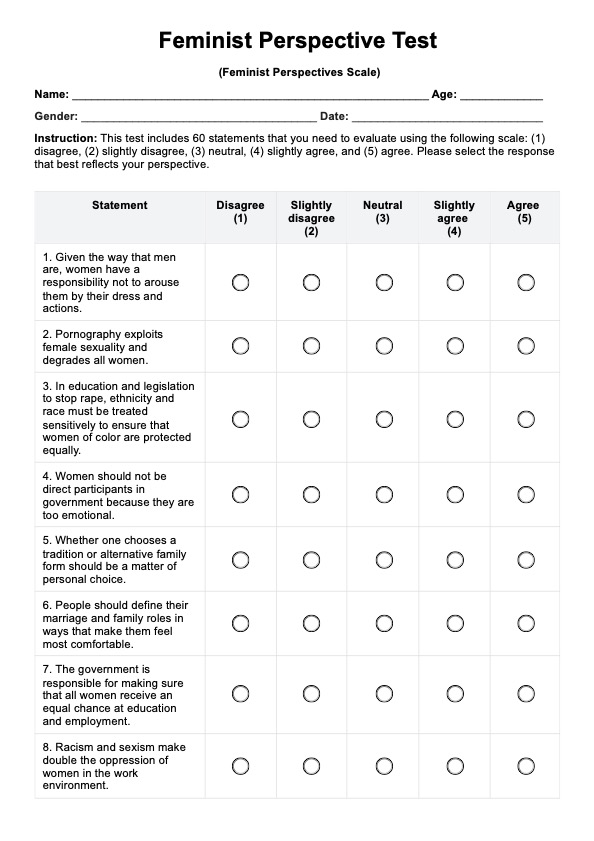Budget Healthy Meal Plan
Looking for a budget-friendly and healthy meal plan? Download Carepatron's free PDF, which includes an example meal plan to help you eat well without breaking the bank.


What does a healthy meal plan entail?
A budget healthy meal plan is a thoughtfully crafted approach to nutrition that balances the need for wholesome, nutritious foods with the constraints of a limited budget. It involves making conscious, healthy meals to prioritize affordable yet nutritious ingredients, ensuring your dietary requirements are met without breaking the bank. In essence, it's about maximizing the nutritional value of your meals while minimizing the impact on your wallet.
This meal plan emphasizes whole foods like fruits, vegetables, lean proteins, and whole grains. These ingredients tend to be more cost-effective and offer many health benefits. By opting for fresh produce and unprocessed foods, you contribute to your well-being and create a sustainable eating routine that won't strain your finances.
A budget healthy meal plan is crucial for various reasons. Firstly, it helps individuals and families maintain a balanced diet, ensuring they receive essential nutrients for optimal health. This approach mainly benefits those with financial constraints, allowing them to prioritize nutrition without compromising quality. Secondly, it fosters long-term habits that promote well-being, creating a foundation for a healthier lifestyle.
This type of meal planning is relevant to anyone seeking a practical and sustainable way to eat nutritiously within their means. Whether you're a student on a tight budget, a young professional starting, or a family looking to save money without sacrificing health, a budget healthy meal plan is a versatile solution. It empowers individuals to make informed choices about their dietary intake, promoting a balance between nutritional value and affordability.
Budget Healthy Meal Plan Template
Budget Healthy Meal Plan Example
Is it true that healthy eating costs more?
There's a common misconception that healthy eating comes with a hefty price tag, but the truth is more nuanced. While it's true that some health food trends and specialty items can be pricey, the foundation of a budget healthy meal plan lies in strategic grocery shopping, meal planning, and minimizing waste.
One of the keys to saving money on a healthy diet is thoughtful grocery shopping and practical meal planning. By creating a weekly or monthly shopping list, you can focus on essential items, avoid impulse purchases, and stick to your grocery budget. According to research by Utah State University (2020), planning healthy meals allows you to buy in bulk when ingredients are on sale and helps prevent last-minute, more expensive, and less healthy food choices.
Contrary to popular belief, nutritious food doesn't have to break the bank. Staples like beans, lentils, whole grains, and seasonal fruits and vegetables are often more affordable than processed or convenience foods. Opting for generic or store-brand items can contribute significant savings without sacrificing nutritional value.
Another aspect that contributes to the affordability of a healthy meal plan is minimizing waste. According to Lynch (2018), planning meals, using leftovers creatively, and storing perishables properly can help extend the lifespan of your groceries, ensuring that you get the most out of your purchases.
To balance healthy eating and budget constraints, consider seeking advice from a registered dietitian. These professionals can provide personalized guidance on creating a budget healthy meal plan tailored to your nutritional needs and financial considerations.
With strategic planning, mindful grocery shopping, and a focus on cost-effective yet nutritious ingredients, it is possible to enjoy healthy meals without overspending.
What is a Budget-Friendly Healthy Meal Plan?
A budget-efficient healthy meal plan is designed to be both nourishing and cheap healthy, proving that wholesome eating doesn't have to strain your finances. You can create satisfying and flavorful dishes without breaking the bank by incorporating cost-effective yet nutritious ingredients and emphasizing innovative meal prep strategies.
Foundation of the plan
At the core of a budget-efficient healthy meal plan are affordable staples such as brown rice, whole-grain pasta, brown rice, and basmati rice. These whole grains provide essential nutrients like fiber and complex carbohydrates, contributing to a well-balanced diet. You can create nutritious, cheap, healthy meals paired with lean proteins like slow cooker chicken thighs, canned chickpeas, hard-boiled eggs, a sliced banana, and frozen fish.
Incorporating pantry staples
Pantry must-haves like tomato sauce, canned veggies, and shelf-stable items are crucial in a budget-efficient healthy meal plan. These items often have a long shelf life, allowing you to buy in bulk and use them over time. Canned vegetables, canned tuna, and chickpeas, for example, are versatile, adding nutritional value and texture to various dishes. However, you may use fresh ones for healthy meals and as a budget tip, such as fresh fish, green beans, sweet potatoes, and more.
Fresh veggies for flavor and nutrition
While pantry staples are essential, incorporating fresh vegetables is equally crucial for flavor and nutrition. Utilizing leftover veggies and buying in-season produce can be cost-effective. Consider meal prepping to make the most of your fresh ingredients, ensuring they don't go to waste and are readily available for a quick and healthy dinner.
Mindful choices for health
Opting for low-sodium and shelf-stable options contributes to the health aspect of the plan. Choosing items with minimal processing and additives allows you to control the nutritional content of your meals. This not only enhances the flavor but also supports your overall well-being.
Smart time and cost management
Consider cooking in batches to save both time and money. Utilize leftovers creatively by incorporating them into the next day's meals. For example, leftover grilled chicken can be added to salads, and extra vegetables can be included in stir-fries or omelets.
How does our Budget Healthy Meal Plan work?
The heart of Carepatron's Budget Healthy Meal Plan lies in its budget-friendly recipes that prioritize health without compromising flavor. Each recipe is carefully curated to meet nutritional standards while keeping costs in check. The emphasis is on creating meals that are good for your well-being and friendly to your wallet.
Step 1 - Browse the recipe collection
Explore Carepatron's diverse collection of recipes tailored explicitly for meals on a budget. From quick and easy options to big-batch recipes suitable for leftovers, the collection covers various preferences and dietary needs.
Step 2 - Assess per-serving costs
One standout feature of Carepatron's Budget Healthy Meal Plan is its attention to per-serving costs. Each recipe provides a clear breakdown of the cost per serving, empowering you to make informed choices based on your budget constraints.
Step 3 - Evaluate cooking time
Efficiency in the kitchen is essential, especially for those with busy schedules. Carepatron's plan factors in cooking time, ensuring the recipes are affordable and feasible for individuals looking to prepare healthy dinners without spending hours in the kitchen.
Step 4 - Embrace big-batch cooking
The plan encourages big-batch cooking for those seeking to maximize their time and resources. By preparing more significant quantities of a meal, you save on ingredients and have ready-made options for future meals, simplifying your daily cooking routine.
What are the benefits of following a Budget Healthy Meal Plan?
Having a budget healthy meal plan offers a lot of advantages. To name a few, here are some you can keep in mind:
Enhanced financial well-being
Creating and sticking to a budget healthy meal plan enhances financial well-being. Individuals can significantly reduce monthly grocery expenses by prioritizing cost-effective yet nutritious ingredients. This helps in immediate financial savings and establishes a sustainable and economical approach to food consumption, aligning with long-term financial goals.
Improved nutritional intake
One of the primary benefits of a budget healthy meal plan is its improved nutritional intake. Individuals ensure they receive a diverse range of essential nutrients by focusing on whole foods like fruits, vegetables, lean proteins, and whole grains. This can lead to better overall health, improved energy levels, and a reduced risk of nutritional deficiencies.
Streamlined meal preparation
Following a budget healthy meal plan streamlines meal preparation and saves valuable time. By planning and embracing batch cooking, individuals can reduce the need for frequent grocery store visits and spontaneous, potentially more expensive, meal choices. This efficiency in meal preparation not only aids in time management but also minimizes food waste, contributing to a more sustainable lifestyle.
Establishing healthy eating habits
Adopting a budget healthy meal plan lays the foundation for establishing and maintaining healthy eating habits. The routine of mindful grocery shopping, meal planning, and choosing nutritious ingredients becomes a lifestyle, promoting long-term well-being. This habit formation can positively impact weight management, heart health, and overall longevity.
Versatility and creativity in cooking
A budget healthy meal plan encourages versatility and creativity in cooking. With a focus on affordable yet wholesome ingredients, individuals are prompted to explore new recipes, cooking techniques, and flavor combinations. This makes the meal preparation process more enjoyable and fosters a deeper appreciation for the diversity of nutritious foods.
References
Lynch, K. (2018). Meal planning can improve health and reduce food waste. https://www.canr.msu.edu/news/meal_planning_can_improve_health_and_reduce_food_waste
Utah State University. (2020). Food waste prevention part 2: meal planning. https://extension.usu.edu/nutrition/research/food-waste-part-2
Commonly asked questions
Eating healthy on a $40 weekly budget requires strategic planning. Opt for cost-effective staples like rice, beans, and frozen vegetables. Buy in bulk, prioritize whole foods, and consider batch cooking for efficiency. Plan meals, avoid unnecessary snacks, and be mindful of portion sizes to stretch your budget while maintaining a nutritious diet.
Planning a healthy budget meal involves incorporating affordable yet nutrient-dense ingredients. Base meals on staples like rice, pasta, and legumes. Utilize seasonal and discounted produce, and consider frozen or canned options for variety. Plan your weekly meals, minimizing food waste by using leftovers creatively. Prioritize whole foods and lean proteins for a balanced and budget-friendly approach.
Eating healthy on a $20 weekly budget requires careful consideration. Focus on low-cost essentials such as oats, eggs and affordable vegetables like carrots and cabbage. Purchase generic brands and explore discount stores for budget-friendly options.





















-template.jpg)


























































































